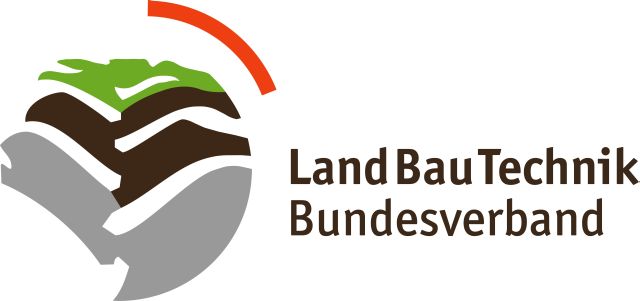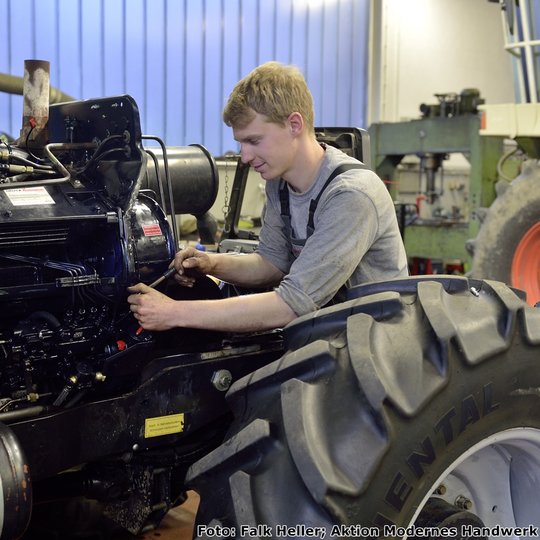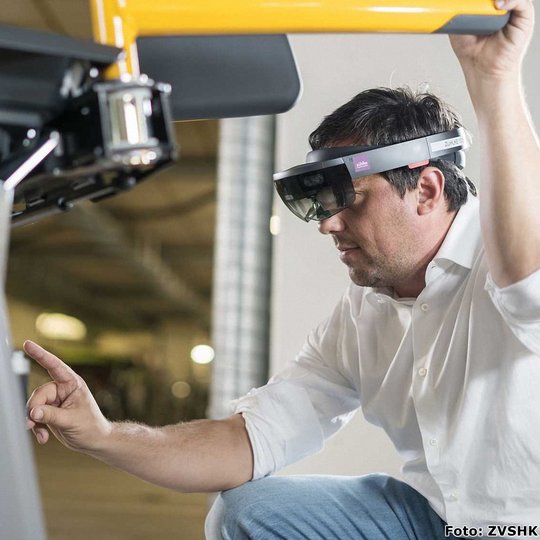"A Changing World of Work": Leseverstehen im Englisch-Unterricht
Dieser Fachartikel beleuchtet das Thema "A Changing World of Work" und richtet sich speziell an Englisch-Lehrkräfte der Oberstufe und ihre Schülerinnen und Schüler in Grund- und Leistungskurs auf Sprachniveau B1/B2. Thematisch setzt er sich mit aktuellen Entwicklungen in der Arbeitswelt, dem Einfluss von Technologie und den Veränderungen im Arbeitsumfeld auseinander. Er eignet sich als Fortbildungsmaterial für Englisch-Lehrkräfte oder als Text- und Leseverstehen im Englisch-Unterricht der Sekundarstufe II.
- Englisch
- Sekundarstufe II

A changing world of work: technology and working environment
The world is facing numerous changes due to a growth in population and climate change. The English Curriculum in secondary school is taking the issue of challenges of our time in terms of nature and environment into account as well as the issue of modelling the future. Using the example of mechatronics for agricultural and construction machinery with focus on agriculture, this professional article focusses on changing technological advancements and demands in agriculture on the one hand. On the other hand, it approaches sustainability, environmental protection, artificial intelligence, technology and working environment. It serves as an informational basis for teachers and students of the Sekundarstufe II and may be integrated into further didactic concepts.
Our world´s population is growing fast, and we will need more food, water, energy and other resources essential for life and prosperity. It seems like an enormous challenge, but also presents amazing opportunities for certain professions such as mechatronics for agricultural and construction machinery who use their skills to involve and maintain cutting edge technology, machines and robots to prevent from crop shortfalls in a sustainable way.
Focus on agricultural prospect: mechatronics for agricultural and construction machinery
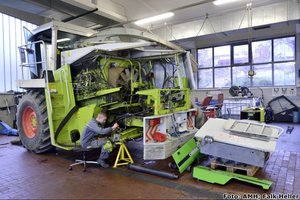
Mechatronics for agricultural and construction machinery are tradespeople who repair, maintain, and overhaul agricultural and construction machinery, power tools and industrial trucks. They work in various settings such as workshops, building yards, customers' premises and in road construction. In recent years, the job profile has changed significantly due to the advancement of digitalisation, similar to many other trades. Originally, the focus of this trade was exclusively on metalworking, maintenance, repair, and the production of mechanical components and assemblies. Nowadays, the emphasis is increasingly shifting towards sensor technology, (electro)hydraulics, IT, and control technology within the overall mechatronic systems of machines and devices, which are now part of daily work.
With regard to agriculture, they deal with farm machinery, farm structures, farm drainage, soil management and erosion control, water supply and irrigation, rural electrification and the processing of farm products. It is meant to improve the efficiency of farms and agribusiness enterprises and to ensure sustainability of natural and renewable resources.
In Germany, training to become mechatronic for agricultural and construction machinery involves 3,5 years of vocational training. (Lücking, 2024)
Recent and future trends in agricultural technologization

Agriculture has undergone many changes over the centuries, but the introduction and development of agricultural technology in recent decades is without doubt one of the most revolutionary. These technologies have not only changed the way farmers tend their fields, but also the way we think about food production and consumption.
Agriculture as we know it is the result of centuries of evolution and adaptation to meet the needs of a growing population. Historically, people relied on manual techniques to cultivate fields, plant and harvest. But in the age of technology, we are witnessing a profound transformation in agriculture – agrotechnology, which refers to the use of technological advances and machinery to optimize farming processes. This includes not only heavy machinery such as tractors and combines, but also software solutions, sensor technology and artificial intelligence that help make better decisions on the field. (Schmidt, 2024)
Like in many other areas in our lives, digitalisation has made it possible to collect, analyse and use agricultural data in real time. For example, GPS-lead machines allow farmers to plant seeds precisely, while sensors in the soil provide data on moisture and nutrient levels. This information can be used to control irrigation and fertilization more precisely, saving resources and increasing yields.
The trade mechatronics for agricultural and construction machinery was once mainly associated with mechanical solutions like the repair of tractors. It has evolved significantly over the past few decades and today we talk about smart farming – a practice where advanced technologies and the Internet of Things help make operations more efficient, sustainable and productive.
Although technology plays a vital role in modern agriculture, humans remain at the heart of it all. Farmers, tradespeople like mechatronics for agricultural and construction machinery and scientists work hand in hand to put technology to good use, bringing their knowledge of plants, animals and ecosystems to ensure that technology meets the real needs of agriculture. Today´s agricultural work environment represents a new era, where technology and human expertise work together to meet the challenges of tomorrow. (Shi et al., 2024)
Technology trends and their impact
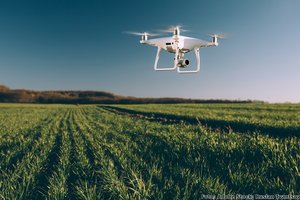
With rapid advances in technology, we are seeing a new wave of innovations that have the potential to fundamentally change the way we produce and consume food. Following, some of the dominant technology trends and their impact on the agricultural sector will be discussed.
Automation and robotics on farmland
The application of robotics in agriculture ranges from autonomous tractors to robotic harvesters to automated milking systems. These machines can perform repetitive and physically demanding tasks while ensuring precision and consistency.
Automation has the advantage that it reduces labor cost, increases efficiency and leads to higher yields. It also enables production around the clock and maximises productivity. On the downside, there are concerns about job losses, besides the need to train workers on using these robots.
Drone technology for field monitoring
Drones equipped with advances sensors can monitor large areas from the air and provide high-resolution images. They can provide information about soil moisture, pests or diseases.
Drones allow precise monitoring of fields, allowing farmers to make proactive decisions about irrigation, fertilization and pest control. This leads optimized yields, reduced use of chemicals and resource conservation.
Precise farming: Data-driven agriculture
By combining sensor technology, data analytics and automated systems, farmers can make precise decisions based on real-time data. This includes decisions about seeding, fertilization, irrigation and harvesting. This helps to increase yield, conserve resources and reduce the ecological footprint which not only leads to more profitable farming but also to more sustainable and environmentally friendly production.
The Importance of Mechanical and Hydraulic Expertise
Despite the focus on digital advancements, traditional mechanical skills remain crucial. Diagnosing and repairing engines, transmissions, and hydraulic systems are fundamental tasks for mechatronics professionals. These skills ensure the reliability and longevity of agricultural machinery, complementing the benefits brought by advanced technologies.
Outlook: How will agriculture change?
Overall, it is evident that current technology trends in agricultural technology have the potential to radically transform the agricultural sector.
The benefits are obvious – from increased productivity to more sustainable practices – but there are also challenges and concerns that need to be considered, including ethical and social issues related to automation and job loss. We have to use these technologies responsibly and sensibly and in harmony with the needs of farmers, consumers and the planet. (agrar-PR, 2023)
Internet addresses used
Agrar-PR (2023). "Die Zukunft der Agrartechnik". Agrar Presseportal. https://www.agrar-presseportal.de/landwirtschaft/landtechnik/die-zukunft-der-agrartechnik-37890.html.
Süß, Helmuth. "Hightech im Kuhstall". Bayrisches Landwirtschaftliches Wochenblatt. Online: www.wochenblatt-dlv.de/feld-stall/landtechnik/hightech-kuhstall-reise-agrartechnik-geht-575658.
Lücking, H. (2024). "Lernen und Erleben". Bundesverband DEULA. Online: https://www.deula.de/bundesverband-deula-e-v/lernen-und-erleben.
Literature used
Brown, R.H. (1988). CRC handbook of engineering in agriculture. Boca Raton, Florida.: CRC Press.
Field, H. L., Solie, J. B., & Roth, L. O. (2007). Introduction to agricultural engineering technology: a problem solving approach. New York: Springer.
Moßmer, A. (2022). Das große Buch der Landtechnik. München: Gera Mond Verlag.
Grenzdörffer, G. (2022). Drohnen in der Landwirtschaft. Übersicht und Potenzial. Darmstadt: KTBL.
Article "A changing world of work: technology and working environment" for download
- Article "A changing world of work: technology and working environment"
This professional article examines technological advancements and demands in agricultural mechatronics, emphasizing sustainability, environmental protection, artificial intelligence, technology, and the working environment.
Further information
- What does an agricultural engineer do?
Here you can find more information about what an agricultural engineer does.
- Association for Agricultural Engineering
On this website, you can find extensive information about the VDMA's Agricultural Machinery Association.
- News and updates about the agricultural engineering industry
On this website, you can find the latest news and updates about the agricultural engineering industry, including market trends, product launches, company announcements, and technological advancements.





